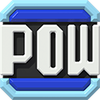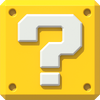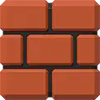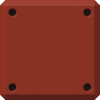Block
- This article is about the blocks found throughout the Mario franchise. For other uses of the term "Block", see Block (disambiguation).
| Block | |||
|---|---|---|---|
    Various blocks in the Super Mario franchise | |||
| First appearance | Mario Bros. (1983) | ||
| Latest appearance | Super Mario Galaxy + Super Mario Galaxy 2 (2025) | ||
| |||
| |||
- “Do you know why blocks exist? For smashing, that's why!”
- —Wario, Wario Land: Shake It!
Blocks in the Super Mario franchise are one of the most recurring and ubiquitous types of objects. Though there are various types, most blocks are suspended in the air or are part of the terrain. Due to their tileable nature, blocks are often used as platforming elements, making up large sections of levels in the 2D platform games in the Super Mario series. When hit from below or the sides, most blocks bump up, hitting objects on top of it. This includes other players and, most commonly, enemies. The first block that appeared in the franchise was the POW Block in Mario Bros., although floors from that game also allow the player to hit enemies by jumping from below.
The appearance and purpose of blocks vary depending on the type of block. Some, such as the ? Blocks, Gold Blocks, and Hidden Blocks, release items such as coins, power-ups, and 1-Up Mushrooms when hit, turning into Empty Blocks afterwards. Others, such as Brick Blocks and Rotating Blocks, can be destroyed, or temporarily disabled, when hit, although some Brick Blocks release items instead. Certain blocks such as Hard Blocks and Donut Blocks act primarily as platforms, while Note Blocks, for example, have special platforming properties and store items within them.
In role-playing games such as those in the Paper Mario series and Mario & Luigi series, blocks largely retain their usual functions, with specific types added to compliment the exploration- and battle-oriented gameplay of those series. Blocks such as Command Blocks in Mario & Luigi are used as the primary way of battling, while Save Blocks and Recovery Blocks, which appear in both series, can save the player's progress and heal their HP, respectively.
While regular blocks appear in the Mario Party series, a special type of block called a Dice Block appears as the primary method players can use to move around boards. Despite usually being six-sided, Dice Blocks can have more than six results, usually the numbers 1 through 10. Different Dice Blocks can have varying effects, such as increasing or decreasing the number of spaces a player can walk, giving or removing items from players and their opponents, or making it easier to land on a specific space.
Gallery[edit]
Super Mario series[edit]
Super Mario RPG: Legend of the Seven Stars[edit]
Paper Mario series[edit]
Mario & Luigi series[edit]
Mario Party series[edit]
Yoshi franchise[edit]
Wario franchise[edit]
Miscellaneous[edit]
Names in other languages[edit]
| Language | Name | Meaning | Notes |
|---|---|---|---|
| Japanese | ブロック[1] Burokku |
Block | |
| Arabic | حجز[2] Hjz |
Block | |
| Catalan | Bloc[?] | Block | The Super Mario Bros. Movie |
| Chinese (Simplified) | 砖块[3] Zhuānkuài |
Brick | |
| Chinese (Traditional) | 磚塊[?] Zhuānkuài |
Brick | |
| Finnish | Lohko[4] | Block | |
| French | Bloc[5] | Block | |
| German | Block[6] | - | |
| Greek | Εμποδίζω[7] Empodízo |
Block | |
| Italian | Blocco[8][9] | Block | |
| Cubo[10] | Cube | Super Mario World television series, "Ghosts 'R' Us" | |
| Korean | 차단[11] Chadan |
Block | The Adventures of Super Mario Bros. 3 |
| Polish | Blok[12] | Block | |
| Sześcian[13] | Cube | Super Mario World television series, "Ghosts 'R' Us" | |
| Romanian | Bloc[14] | Block | |
| Cub[15] | Cube | Super Mario World television series, "Ghosts 'R' Us" | |
| Russian | Блок[16] Blok |
Block | |
| Spanish | Bloque[17] | Block | |
| Spanish (Latin America) | Cubo[18] | Cube | Super Mario World television series, "Ghosts 'R' Us" |
| Swedish | Block[19] | - |
See also[edit]
References[edit]
- ^ 1985. スーパーマリオブラザーズ (Sūpā Mario Burazāzu) instruction booklet. Nintendo. Page 9.
- ^ سوبر ماريو - سبيس تون
- ^ 【720P高清修复】超级马里奥兄弟3 TV版动画【1990年】【中文语音字幕】【全26集】
- ^ The Adventures Of Super Mario Bros. 3 | All Episode In Finnish [2013 DVD Version]
- ^ Les aventures de Super Mario Bros 3 015 En avant la musique
- ^ The Adventures of Super Mario Bros. 3 Staffel 1 Folge 15 HD Deutsch
- ^ The Adventures of Super Mario Bros 3 Greek [Επεισόδια 15-16]
- ^ Super Mario Bros. 3 (3DS - Virtual Console) Italian e-manual. Page 13.
- ^ Super Mario Land (3DS - Virtual Console) Italian e-manual. Page 10.
- ^ Le avventure di Super Mario - Episodio 4 - Fantasmi a colazione
- ^ The Adventures of Super Mario Brothers 3 Korean Dub 슈퍼마리오 3 VHS Volumes 1 - 6.
- ^ Nowe Przygody Braci Mario Odcinek 15 - Koopa Dance
- ^ Kapitan N i nowe przygody braci Mario. Odc. 4 - Czuj duch/Totalnie ztetrisowani
- ^ McDonald's Romania 2017 Happy Meal box, Super Mario promotion
- ^ May 20, 2015. "Ghosts 'R' Us", dubbed in Romanian by KidsCo. Odnoklassniki (OK.ru). Retrieved January 4, 2016.
- ^ Мультфильм Супер Марио - 15 серия
- ^ Las Aventuras de los Super hermanos Mario: 15 - Baile En Koopa
- ^ Super Mario World (Cap.4 - Los fantasmas) Español
- ^ The Adventures of Super Mario Bros 3 - Episode 15 - Swedish

















































































